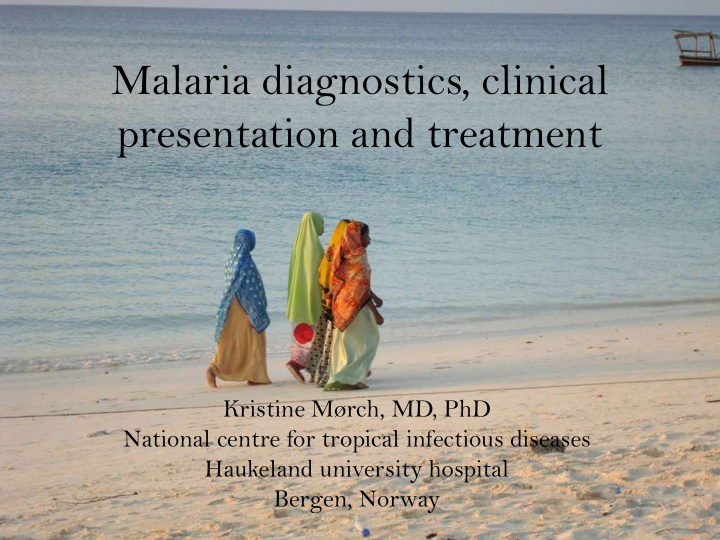



Malaria diagnostics, clinical presentation and treatment Kristine Mørch, MD, PhD National centre for tropical infectious diseases Haukeland university hospital Bergen, Norway
Malaria epidemiology • Globally (WHO report 2014): – 200 million cases – 600 000 deaths • Europe (ECDC report 2014): – 5 161 cases – 1/100 000/year – Imported cases 99%
Malaria Lithuania and Norway 140 120 100 80 Lithuania 60 Norway 40 20 0 2010 2012 2014 ECDC report 2014. MSIS Norway.
Malaria life cycle Anopheles Sporozoites Liver schizont Gametocytes multiply in mosquito Parasites multiply in red cells Merozoite invade red cell
Five species infect humans Potentially severe malaria: • P. falciparum • P knowlesi • (P. vivax) Benign malaria: • P. vivax (usually) • P. ovale curtisi and wallikeri • P. malariae
Uncomplicated malaria – clinical presentation • Unspecific fever • Headache, myalgia, nausea, vomiting, diarrhoea
Severe malaria clinical presentation • Coma (cerebral malaria) • Severe anaemia • Kidney failure Sequestration • Acidosis • Pulmonary oedema • Hypoglycaemia • Spontaneous bleeding • Shock • Haemoglobinuria • Hyperparasitaemia (>2-4%) 7
Diagnostics • Giemsa stained blood slides • Rapid diagnostic tests • PCR
P. falciparum
P. vivax
Rapid diagnostic tests • Detects – Histidine rich protein-2 ( P.falciparum specific) – Plasmodium specific aldolase (pan-malaria) – Plasmodium associated LDH (pan-malaria)
WHO quality assurance reports
PCR • Detects parasite DNA • Most sensitive method • Not available in routine diagnostics
PCR versus microscopy Bergen – Norway Ref: Haanshus, Mohn, Mørch et al. Malaria journal 2013.
PCR versus microscopy globally • Meta analysis: – 70 paired microscopy and PCR estimates from endemic areas (Africa, Asia, Americas) • Microscopy detected 50.8% of malaria cases detected by PCR Okell et al. JID 2009
Artesunate compared to quinine -efficacy • Artesunate reduces mortality in endemic areas: – Relative risk 0.61 in adults – Relative risk 0.75 in children -Sinclair et al, Artesunate versus quinine for treating severe malaria. Cochrane Syst Rev 2011. -Dondorp, et al. AQUAMAT: Lancet, 2010.
Treatment • Severe – Artesunate i.v. – Quinine i.v. – Change from i.v. to a full course of oral drug when condition allows • Uncomplicated P. falciparum – Artemether-lumefantrine – Atovaquone-proguanil – Mefloquine • P. vivax , P. ovale – Chloroquine + primaquine • P. malariae – Chloroquine Ref: WHO guidelines for the treatment of malaria 2010.
• Mørch, Myrvang: Treatment of malaria in Norway. Tidsskr nor legeforen 2012.
Side effects • Artesunate: Post treatment heamolysis – May require repeated blood transfusions – Hgb should be monitored 2-4 weeks after treatment • Quinine: Arrythmia, hypoglycaemia, cinchonism – Infusion slow (2-4 hours) – Cardiac monitoring during infusion
Preparedness for severe malaria in a non-endemic country • Among all hospitals in Norway – 40% (19/48) not artesunate or quinine available – 6% no diagnostic methods available • In Lithuania? Ref: Heggheim, Blomberg, Mørch: Preparedness for severe malaria. Tidsskr Nor Legeforen. 2015.
Malaria patient • Previously healthy doctor • Did not turn up at work as usual • Colleges alarmed the police who found him in his home; confused • Admitted to department of neurology with tentative diagnosis cerebral stroke
Findings • Dysphasia • Awake but confused • RF 40, puls 120, temperature 39 • Sent for MRI
The nurse received information saving the patient
Test results • Malaria rapid test: P . falciparum positiv • Lactate: 10 • Platelets: 11 • Creatinine: 120 • Bilirubin: 121 • LD: 522 • INR 1.4, APTT 46, D-dimer > 20 (DIC)
Blood smear
Blood smear two hours later
Treatment • Artesunate • Exchange transfusion
Thank you for your attention
Klausimai?
Recommend
More recommend